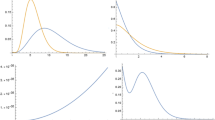Abstract
Two methods for transforming uniformly distributed random numbers into normally distributed random numbers are considered in conjunction with linear congruential generators. The two-dimensional lattice structure of the uniform random numbers is transformed by the Box-Muller method into a spiral structure and by the polar method into a club-shaped structure. The approximation of the two-dimensional normal distribution and the independence of the associated random variables are discussed.
Similar content being viewed by others
References
Afflerbach, L. (1983):Lineare Kongruenz-Generatoren zur Erzeugung von Pseudo-Zufallszahlen und ihre Gitterstruktur. Dissertation, Technische Hochschule Darmstadt.
Afflerbach, L. (1986):The Sub-Lattice Structure of Linear Congruential Random Number Generator. Manuscripta Math. 55, 455–465.
Afflerbach, L.; Grothe, H. (1985):Calculation of Minkowski-Reduced Lattice Bases. Computing 35, 269–276.
Beyer, W.A. (1972):Lattice Structure and Reduced Bases of Random Vectors Generated by Linear Recurrences. In: S.K. Zaremba (Ed.): Applications of Number Theory to Numerical Analysis, 361–370.
Box, J.E.P.; Muller, M.E. (1958):A Note on the Generation of Random Normal Deviates. Ann. Math. Statist., 29, 610–611.
Bratley, P.; Fox, B.L.; Schrage, L.E. (1983):A Guide to Simulation. Springer: New York, Berlin, Heidelberg, Tokyo.
Chay, S.C.; Fardo, R.D.; Mazumdar, M. (1975):On Using the Box-Muller Transformation with Multiplicative Congruential Pseudo-random Number Generators. Appl. Statist., 24, 132–135.
Devroye, L. (1986):Non-Uniform Random Variate Generation. Springer: New York, Berlin, Heldelberg, Tokyo.
Dieter, U.; Ahrens, J. (1986):Uniform Random Numbers. Institut f. Math. Stat., Technische Universität Graz.
Dieter, U.; Ahrens, J. (1986):Nonuniform Random Numbers. Manuscript, Technische Universität Graz.
Knuth, D.E. (1981):The Art of Computer Programming, Vol II, 2d ed. Addison-Wesley: Reading (Mass.), Menlo Park (Cal.), London, Amsterdamm, Don Mills (Ont.), Sydney.
Marsaglia, G. (1968):Random Numbers Fall Mainly in the Planes. Proc. Nat. Acad. Sci. 61, 25–28.
Marsaglia, G.; Bray, T.A. (1964):A Convenient Method for Generating Normal Variables. SIAM Rev., 6, 260–264.
Neave, H.R. (1973):On Using the Box-Muller Transformation with Multiplicative Congruential Pseudo-Random Number Generators. Appl. Statist., 22, 92–97 (1973).
Ripley, B.D. (1983):The Lattice Structure of Pseudo-Random Number Generators. Proc. R. Soc. Aond. A 389, 197–204.
Ripley, B.D. (1987):Stochastic Simulation. Wiley New York.
Wenzel, K. (1986):Transformationen von Zufallszahlen. Diplomarbeit, FB 4, TH Darmstadt.
Author information
Authors and Affiliations
Rights and permissions
About this article
Cite this article
Afflerbach, L., Wenzel, K. Normal random numbers lying on spirals and clubs. Statistical Papers 29, 237–244 (1988). https://doi.org/10.1007/BF02924529
Received:
Revised:
Issue Date:
DOI: https://doi.org/10.1007/BF02924529




